Natural Swimming Ponds as an Application of Treatment Wetlands—A Review
Abstract
:1. Introduction
1.1. Specificity of Natural Swimming Ponds
1.2. Characteristics of Water Quality in Natural Swimming Ponds
1.3. Treatment Wetland Application in Natural Swimming Ponds
- Planted vertical flow filters with saturated media or freely drained;
- Unplanted vertical flow filters with saturated media or freely drained;
- Free water surface (FWS) wetlands with submerged or emergent vegetation;
- High-rate gravel or technical filters as elements of additional water treatment technology.
2. Structure and Function of a Natural Swimming Pond as a TW Application
3. Modifications of Solutions for the Construction and Operation of Swimming Ponds
- Extensive ponds, usually with 30% of the area designated for free swimming and 70% as a plant (regeneration) zone. Water circulation between these zones takes place owing to natural physical processes, namely different wind strengths and differences in temperature between the warmed shallow zones and the deeper, colder part of the pond. Ponds of this type are fully reminiscent of a natural environment;
- Intensive ponds, where the regeneration zone can be much smaller in relation to the recreation zone, as water circulation is forced by a pump and sometimes by more complicated water filtration systems. These include the use of various types of filters in various functional combinations, in some cases with additional equipment [13].
4. Types of Filters
5. Conclusions
- Modularity based on lightweight polymer components (PE or HDPE) and aluminium, which can be easily multiplied as needed;
- The modularity of individual compartments of the filtration chamber itself, including the mechanical, biological, and mineral compartments, as well as a pump compartment with equipment adapted to the quality parameters of the water used to fill the pond and replenish water lost to evaporation;
- The use of a mineral filter with an adsorbent with proven optimal phosphorus sorption efficiency and the possibility of adding another section to the mineral module;
- Functionality for swimming ponds of all sizes, owing to the possibility of modification based on the modularity of the filtration system, without the need for specialist expertise;
- The possibility of selective filtration while any of the cartridges (mechanical, mineral or biological) are idle, without switching off the water circulation in the pond;
- Adaptation of the technological solution for most types of swimming ponds (types 2–5), owing to the possibility of connecting modules into parallel or serial configurations;
- Trouble-free self-assembly of system components based on a starter pack (basic, factory-equipped) and supplementary modules and dedicated accessories chosen for the given conditions;
- A modular system enabling the easy instalment of a deck on the components of the filtration chamber, helping to mask it and optimize the use of the site;
- Easier maintenance, allowing each part of the filtration module to be detached and effectively cleaned, without the need to inactivate the entire system.
Author Contributions
Funding
Data Availability Statement
Conflicts of Interest
References
- Kircher, W. Vortrag bei der Formation of Urban Green Areas 2007: Water and Plants in Landscape; International Congress: Klaipeda, Litauen, 2007. [Google Scholar]
- FLL (Forschungsgesellschaft Landschaftsentwicklung Landschaftsbau e. V.). Richtlinien für Planung, Bau und Instandhaltung von Privaten Schwimm- und Badeteichen. 2017. Available online: https://www.google.com/url?sa=t&rct=j&q=&esrc=s&source=web&cd=&ved=2ahUKEahUK7yJu_n7AhUJ_SoKHVUdDoQQFnoECBIQAQ&url=https%3A%2F%2Fshop.fll.de%2Fde%2Fdownloadable%2Fdownload%2Fsample%2Fsample_id%2F128%2F&usg=AAOvVa091M0x22ZxpeZTku4M4Dda (accessed on 15 December 2022).
- Casanovas-Massana, A.; Blanch, A.R. Characterization of microbial populations associated with natural swimming pools. Int. J. Hyg. Environ. Health 2013, 216, 132–137. [Google Scholar] [CrossRef] [PubMed]
- Bus, A.Z.; Karczmarczyk, A.A. Kinetic and sorption equilibrium studies on phosphorus removal from natural swimming ponds by selected reactive materials. Fresenius Environ. Bull. 2015, 24, 2736–2741. [Google Scholar]
- Langergraber, G.; Dotro, G. (Eds.) Wetland technology: Practical information on the design and application of treatment wetlands. In Scientific and Technical Report Series; IWA Publishing: London, UK, 2019; Volume 27, p. 191. [Google Scholar]
- Grafinger, R. Schwimmteiche—Gratwanderung zwischen Algen und Technik. Der Schwimmteich 2004, 3, 4–5. [Google Scholar]
- Littlewood, M. Natural Swimming Pools: An Inspirational Guide for Construction and Maintenance; Schiffer Publishing: Atglen, PA, USA, 2005. [Google Scholar]
- Palin, A.T. The determination of free chlorine and of chloramine in water using p-aminodimethylaniline. Analyst 1945, 70, 203–207. [Google Scholar] [CrossRef]
- Giampaoli, S.; Spica, V.R. Health and safety in recreational waters. Bull. World Health Organ. 2014, 92, 79. [Google Scholar] [CrossRef]
- Chowdhury, S.; Alhooshani, K.; Karanfil, T. Disinfection byproducts in swimming pool: Occurrences, implications and future needs. Water Res. 2014, 53, 68–109. [Google Scholar] [CrossRef]
- Florentin, A.; Hautemanière, A.; Hartemann, P. Health effects of disinfection by-products in chlorinated swimming pools. Int. J. Hyg. Environ. Health 2011, 214, 461–469. [Google Scholar] [CrossRef] [PubMed]
- Włodyka-Bergier, A.; Zając, W. Dezynfekcja wody basenowej promieniami UV a zdrowie użytkowników. In Nauka i Wiedza Kluczem Do Poznania Świata; Olkiewicz, M., Drewniak, M., Eds.; Network Solutions: Słupsk, Poland, 2015. [Google Scholar]
- Grudzień, B. Zasilanie basenu otwartego wodą z naturalnych cieków wodnych. Wieś I Doradz. 2011, 1–2, 21–25. [Google Scholar]
- Sinclair, R.G.; Jones, E.L.; Gerba, C.P. Viruses in recreational water-borne disease outbreaks: A review. J. Appl. Microbiol. 2009, 107, 1769–1780. [Google Scholar] [CrossRef]
- Schets, F.M.; De Roda Husman, A.M.; Havelaar, A.H. Disease outbreaks associated with untreated recreational water use. Epidemiol. Infect. 2011, 139, 1114–1125. [Google Scholar] [CrossRef]
- Bruns, S.; Peppler, C. Hygienic quality of public natural swimming pools (NSP). Water Supply 2019, 19, 365–370. [Google Scholar] [CrossRef]
- Piechurski, F. Badania zastosowania różnych rozwiązań urządzeń do wspomagania oczyszczania wody basenowej w krytych pływalniach. Instal 2019, 11, 39–44. [Google Scholar]
- Rozporządzenie Ministra Zdrowia z Dnia 9 Listopada 2015 r. w Sprawie Wymagań, Jakim Powinna Odpowiadać Woda na Pływalniach (Dz.U. 2015, nr 208, poz. 1240). Available online: https://isap.sejm.gov.pl/isap.nsf/DocDetails.xsp?id=wdu20150002016 (accessed on 15 December 2022).
- Wytyczne Głównego Inspektoratu Sanitarnego w Sprawie Wymagań Jakości Wody Oraz Warunków Sanitarno-Higienicznych Na Pływalniach. 2014. Available online: https://www.gov.pl/web/psse-ostroda/wytyczne-glownego-inspektoratu-sanitarnego-w-sprawie-wymagan-jakosci-wody-oraz-warunkow-sanitarno-higienicznych-na-plywalniach (accessed on 15 December 2022).
- Ustawa z Dnia 18 Sierpnia 2011 r. o Bezpieczeństwie Osób Przebywających na Obszarach Wodnych (Dz.U. 2011, nr 208, poz. 1240). Available online: https://isap.sejm.gov.pl/isap.nsf/DocDetails.xsp?id=WDU20112081240 (accessed on 15 December 2022).
- Piechurski, F.; Madej, P. Ocena jakości wody w różnych nieckach basenowych po przeprowadzonej modernizacji systemów jej oczyszczania. Rynek Instal. 2021, 9, 94–103. [Google Scholar]
- Standardy pro Plánování, Stavbu a Provoz Koupacích Jezírek a Biobazénů. 2014. Available online: http://www.jezirka-biobazeny.cz/cs/biobazeny/koupaci-jezirka-a-biobazeny/standardy-pro-stavbu-a-provoz (accessed on 15 December 2022).
- Available online: www.stawy-kapielowe.com.pl (accessed on 15 December 2022).
- Wolski, P.; Gąsiorowski, M.; Walczak, W. Stawy kąpielowe—Formy bliskie naturze. Archit. Kraj. 2001, 2–3, 85–94. [Google Scholar]
- Chowdhury, S.; Rodriguez, M.J.; Sadiq, R. Disinfection byproduct in Canadian provinces: Associated cancer risk and medical expences. J. Hazard. Mater. 2011, 187, 574–584. [Google Scholar] [CrossRef] [PubMed]
- Włodyka-Bergier, A.; Bergier, T. Badania wpływu promieniowania nadfioletowego na stabilność mikrobiologiczną wody. Ochr. Środowiska 2015, 37, 47–50. [Google Scholar]
- Dhote, S.; Dixit, S. Water quality improvement through macrophytes—A review. Environ. Monit. Assess. 2009, 152, 149–153. [Google Scholar] [CrossRef]
- Radic, D.; Gujanicic, V.; Petricvic, J.; Raicevic, V.; Lalevic, B.; Rudic, Z.; Bozic, M. Macrophytes as remediation technology in improving Ludas lake sediment. Fresenius Environ. Bull. 2013, 22, 1787–1791. [Google Scholar]
- Stefanakis, A.I.; Akratos, C.S. Removal of pathogenic bacteria in constructed wetlands: Mechanisms and efficiency. In Phytoremediation; Ansari, A., Gill, S., Gill, R., Lanza, G., Newman, L., Eds.; Springer International: Cham, Switzerland, 2016; pp. 327–346. [Google Scholar]
- Weber, K.P.; Legge, R.L. Pathogen removal in constructed wetlands. In Wetlands: Ecology, Conservation and Restoration; Russo, R.E., Ed.; Nova Publishers: New York, NY, USA, 2008; pp. 176–211. [Google Scholar]
- Vymazal, J. Removal of enteric bacteria in constructed treatment wetlands with emergent macrophytes: A review. J. Environ. Sci. Health 2005, 40, 1355–1367. [Google Scholar] [CrossRef]
- Wu, S.; Carvalho, P.N.; Müller, J.A.; Manoj, V.R.; Dong, R. Sanitation in constructed wetlands: A review on the removal of human pathogens and fecal indicators. Sci. Total Environ. 2016, 541, 8–22. [Google Scholar] [CrossRef]
- Gorito, A.M.; Ribeiro, A.R.; Almeida, C.M.R.; Silva, A.M. A review on the application of constructed wetlands for the removal of priority substances and contaminants of emerging concern listed in recently launched EU legislation. Environ. Pollut. 2017, 227, 428–443. [Google Scholar] [CrossRef]
- Vymazal, J.; Březinová, T.D.; Koželuh, M.; Kule, L. Occurrence and removal of pharmaceuticals in four full-scale constructed wetlands in the Czech Republic–the first year of monitoring. Ecol. Eng. 2017, 98, 354–364. [Google Scholar] [CrossRef]
- Button, M.; Cosway, K.; Sui, J.; Weber, K.P. Impacts and fate of triclosan and sulfamethoxazole in intensified re-circulating vertical flow constructed wetlands. Sci. Total Environ. 2019, 649, 1017–1028. [Google Scholar] [CrossRef] [PubMed]
- Serafin, A.; Sender, J.; Bronowicka-Mielniczuk, U. Potential of Shrubs, Shore Vegetation and Macrophytes of a Lake to Function as a Phytogeochemical Barrier against Biogenic Substances of Various Origin. Water 2019, 11, 290. [Google Scholar] [CrossRef]
- Traczewska, T.M. Biologiczne Metody Oceny Skażenia Środowiska; Oficyna Wydawnicza Politechniki Wrocławskiej: Wrocław, Poland, 2011. [Google Scholar]
- Button, M.; Auvinen, H.; Van Koetsem, F.; Hosseinkhani, B.; Rousseau, D.P.L.; Weber, K.P.; Du Laing, G. Susceptibility of constructed wetland microbial communtities to silver nanoparticles: A microcosm study. Ecol. Eng. 2016, 97, 476–485. [Google Scholar] [CrossRef]
- Dodds, W.K. The role of periphyton in phosphorus retention in shallow freshwater aquatic systems. J. Phycol. 2003, 39, 840–849. [Google Scholar] [CrossRef]
- Available online: www.psnwk.pl (accessed on 15 December 2022).
- Available online: www.re-natura.pl (accessed on 15 December 2022).
- Wetzel, R.G. Limnology: Lake and River Ecosystems; Gulf Professional Publishing: London, UK; Los Angeles, CA, USA; Tokyo, Japan, 2001. [Google Scholar]
- Brzychczyk, B.; Famielec, S.; Malinowski, M.; Salamon, J. Zastosowanie klinoptylolitu w procesie samooczyszczania wód małych zbiorników wodnych. Probl. Inżynierii Rol. 2015, 3, 71–82. [Google Scholar]
- Ostroumov, S.A. Water quality and conditioning in natural ecosystems: Biomachinery theory of self-purification of water. Russ. J. Gen. Chem. 2017, 87, 3199–3204. [Google Scholar] [CrossRef]
- Szczykowska, J.E.; Siemieniuk, A. Ćwiczenia Laboratoryjne z Technologii Wody; Oficyna Wydawnicza Politechniki Białostockiej: Białystok, Poland, 2020. [Google Scholar]
- Nawrocki, J. Uzdatnianie Wody, Część 1-2; Wydawnictwo Naukowe PWN: Warszawa, Poland, 2010. [Google Scholar]
- Skoczko, I. Filtracja Wody w Teorii i Praktyce; Wydawnictwo Polskiej Akademii Nauk: Warszawa, Poland, 2019. [Google Scholar]
- Magrel, L. Uzdatnianie Wody i Oczyszczanie Ścieków. Urządzenia, Procesy, Metody; Ekonomia i Środowisko: Białystok, Poland, 2000. [Google Scholar]
- Simpson, D. Biofilm processess in biologically active carbon water purification. Water Res. 2008, 42, 2839–2848. [Google Scholar] [CrossRef]
- Połeć, B.; Wołyńska, W. Usuwanie azotu z wód amoniakalnych cukrowni na złożach biologicznych. Postępy Nauk. I Technol. Przemysłu Rolno-Spożywczego 2011, 66, 86–102. [Google Scholar]
- Kołwzan, B.; Adamiak, W.; Grabas, K.; Pawełczyk, A. Podstawy Mikrobiologii w Ochronie Środowiska; Oficyna Wydawnicza Politechniki Wrocławskiej: Wrocław, Poland, 2005. [Google Scholar]
- Krauss, G.J.; Solé, M.; Krauss, G.; Schlosser, D.; Wesenberg, D.; Bärlocher, F. Fungi in freshwaters: Ecology, physiology and biochemical potential. FEMS Microb. Rev. 2011, 35, 620–651. [Google Scholar] [CrossRef] [PubMed]
- Pauli, W.; Jax, K.; Berger, S. Protozoa in wastewater treatment: Function and importance. In Biodegradation and Persistence; Springer: Berlin/Heidelberg, Germany, 2001; pp. 203–252. [Google Scholar]
- Chekroun, K.B.; Sánchez, E.; Baghour, M. The role of algae in bioremediation of organic pollutants. J. Issues 2014, 2360, 8803. [Google Scholar]
- Serafin, A.; Grzywna, A.; Augustyniak, R.; Bronowicka-Mielniczuk, U. Nutrients from beach recreation in the context of the limnological status of a mesotrophic lake. J. Water Land Dev. 2022, 54, 160–171. [Google Scholar] [CrossRef]
- Koźmińska, A.; Hanus-Fajerska, E.; Muszyńska, E. Możliwości oczyszczania środowisk wodnych metodą ryzofiltracji. Woda-Sr.-Obsz. Wiej. 2014, 14, 89–98. [Google Scholar]
- Kajak, Z. Skuteczność różnych metod rekultywacji jezior w celu poprawy czystości ich wód. Wiadomości Ekol. 1981, 27, 331–357. [Google Scholar]
- Ellenberg, H.; Weber, H.E.; Wirth, W.; Düll, R.; Werner, W. Zeigerwerte von Pflanzen in Mitteleuropa. In Scripta Geobotanica 18, 2nd ed.; Lehrstuhl für Geobotanik der Universität Göttingen: Göttingen, Germany, 1992. [Google Scholar]
- Pilon-Smits, E. Phytoremediation; Annual Reviews: Fort Collins, CO, USA, 2005. [Google Scholar]
- Available online: https://majama.pl/DRUMI-filtr-bebnowy-wstepny (accessed on 15 December 2022).
- Available online: https://piekneogrody.com.pl/filtr-modulowy/843-oase-oase-filtr-bebnowy-proficlear-premium-compact-l-egc-49979-zasilany-pompowo-4010052499796.html (accessed on 15 December 2022).
- Available online: www.plantica.pl/oczko-wodne/filtracja-1/filtry-1/przeplywowe (accessed on 15 December 2022).
- Available online: www.plantica.pl/oczko-wodne/filtracja-1/filtry-1/przeplywowe/cbf-350c-filtr-biologiczny-przeplywowy-wklady (accessed on 15 December 2022).
- Gąsiorowski, M.; Pecyna, T. Patent. Zespół Filtracyjny. P.426813. 2018. Available online: https://ewyszukiwarka.pue.uprp.gov.pl/search/pwp-details/P.426813?lng=pl) (accessed on 15 December 2022).

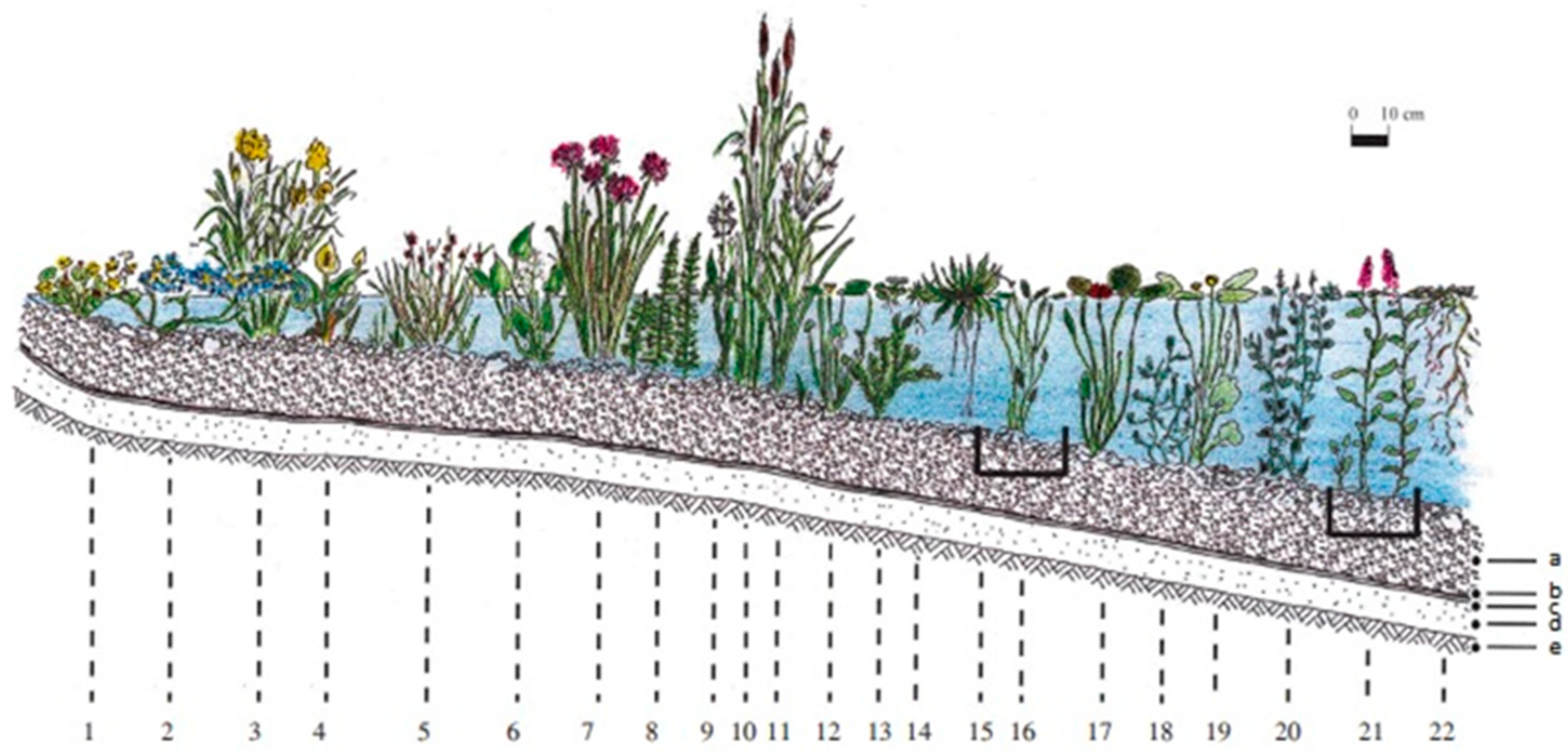


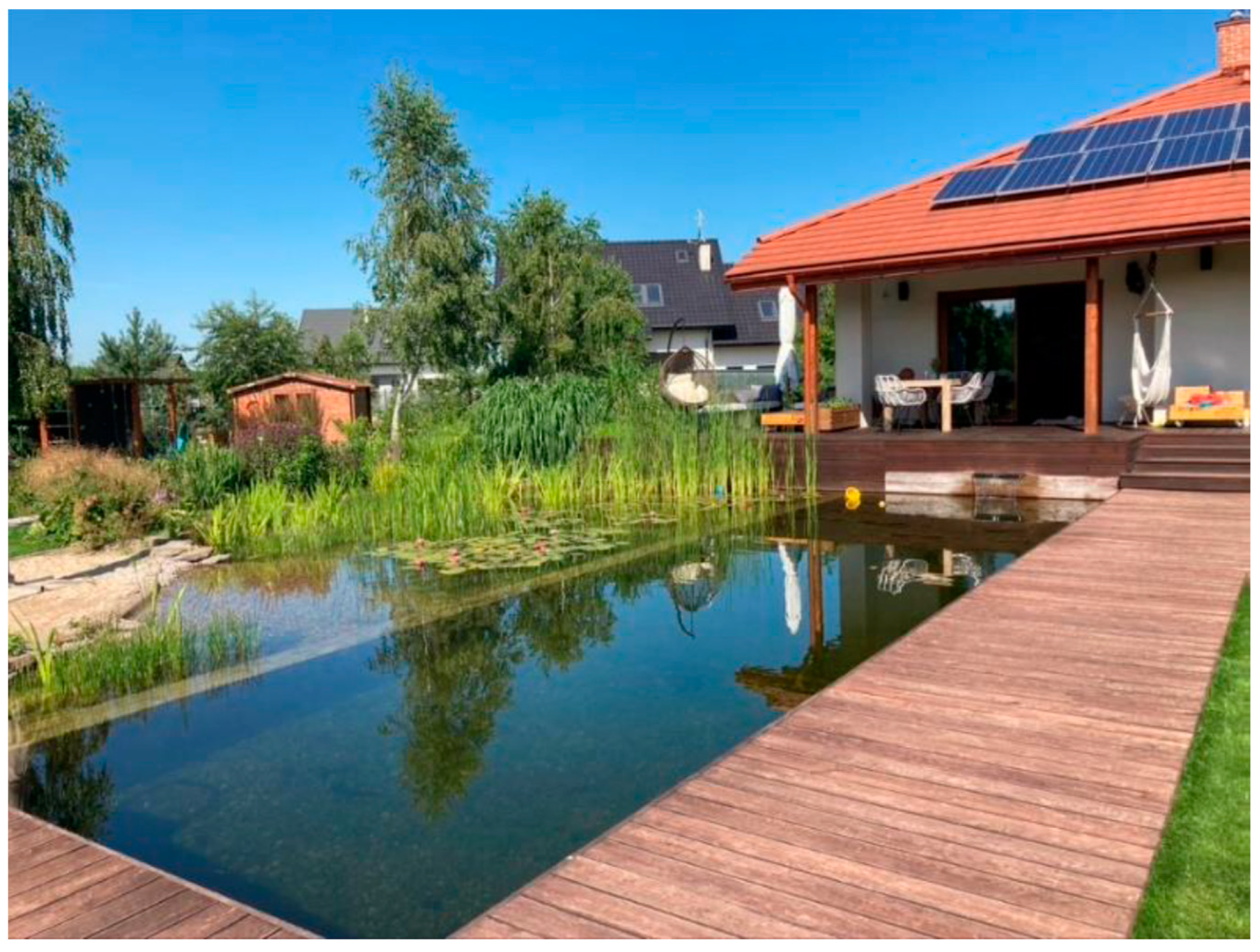


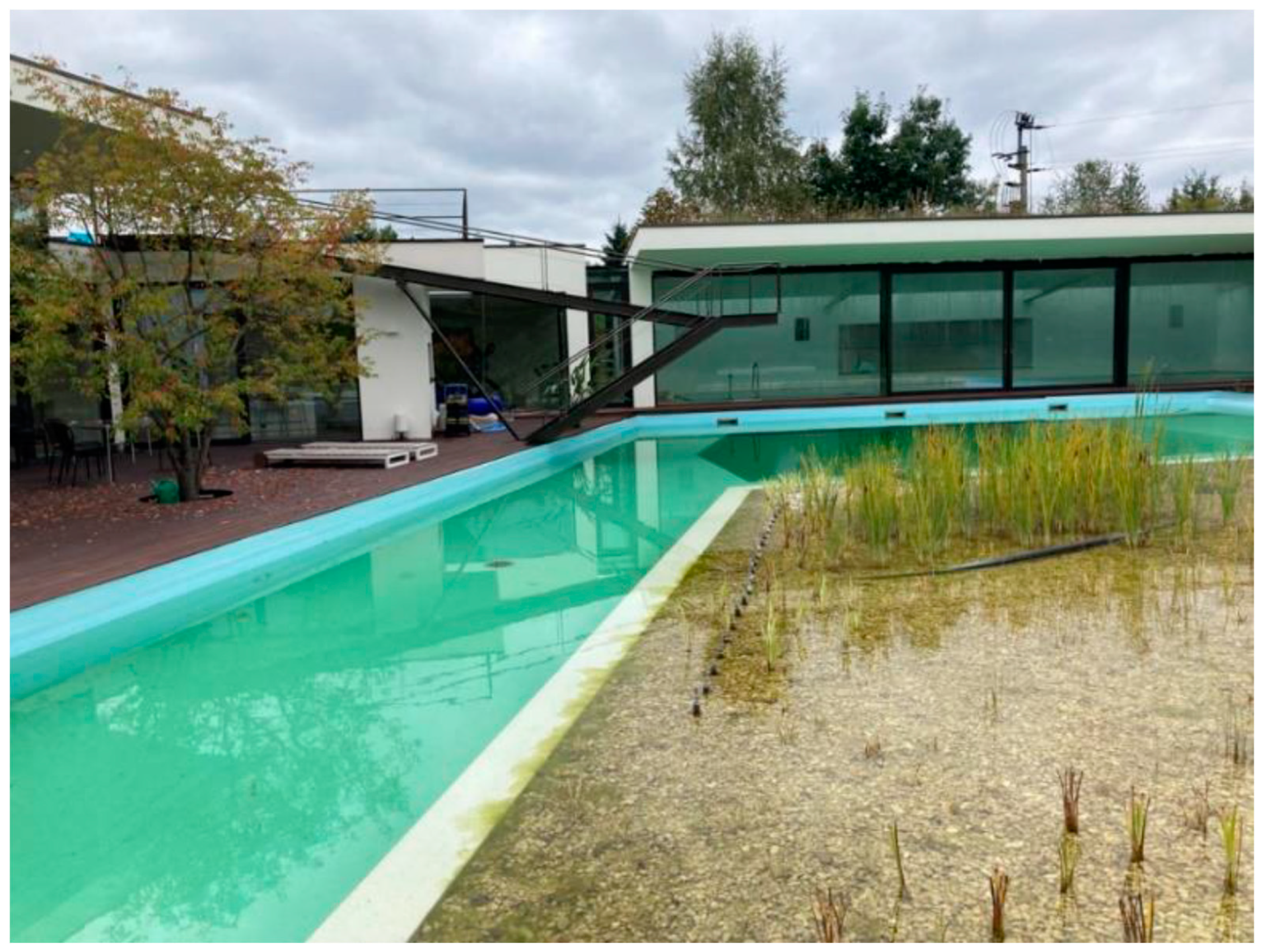

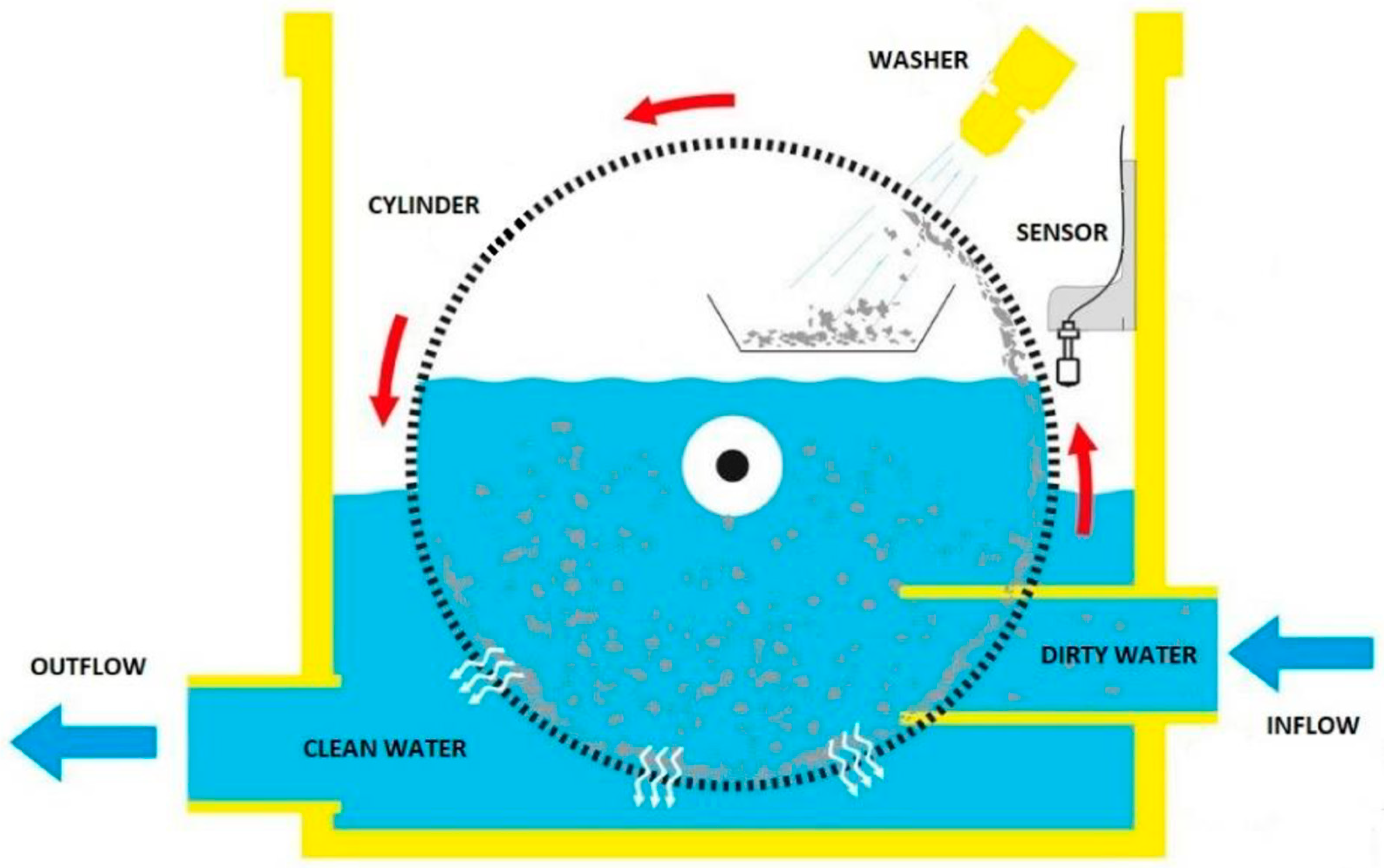
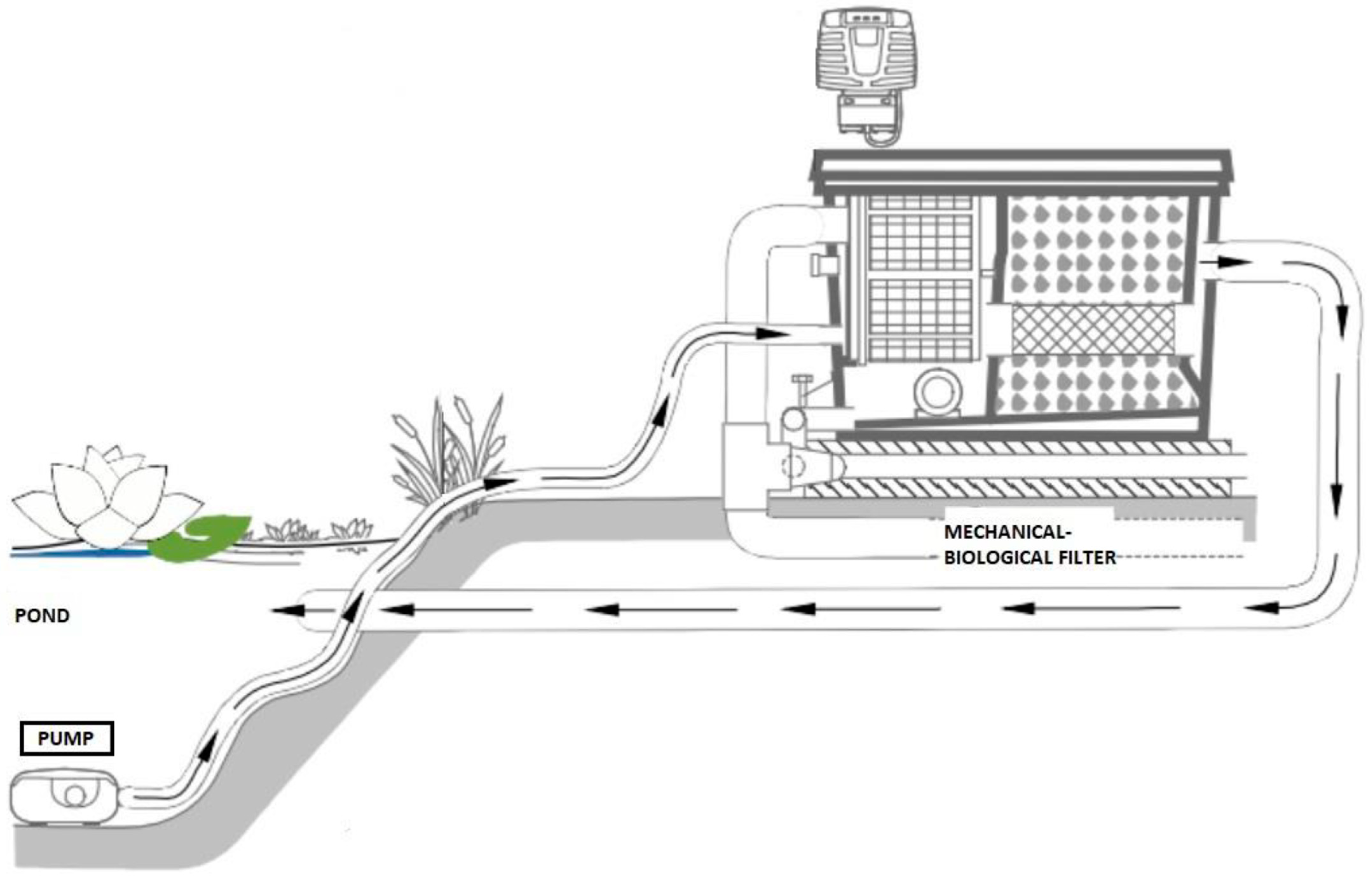

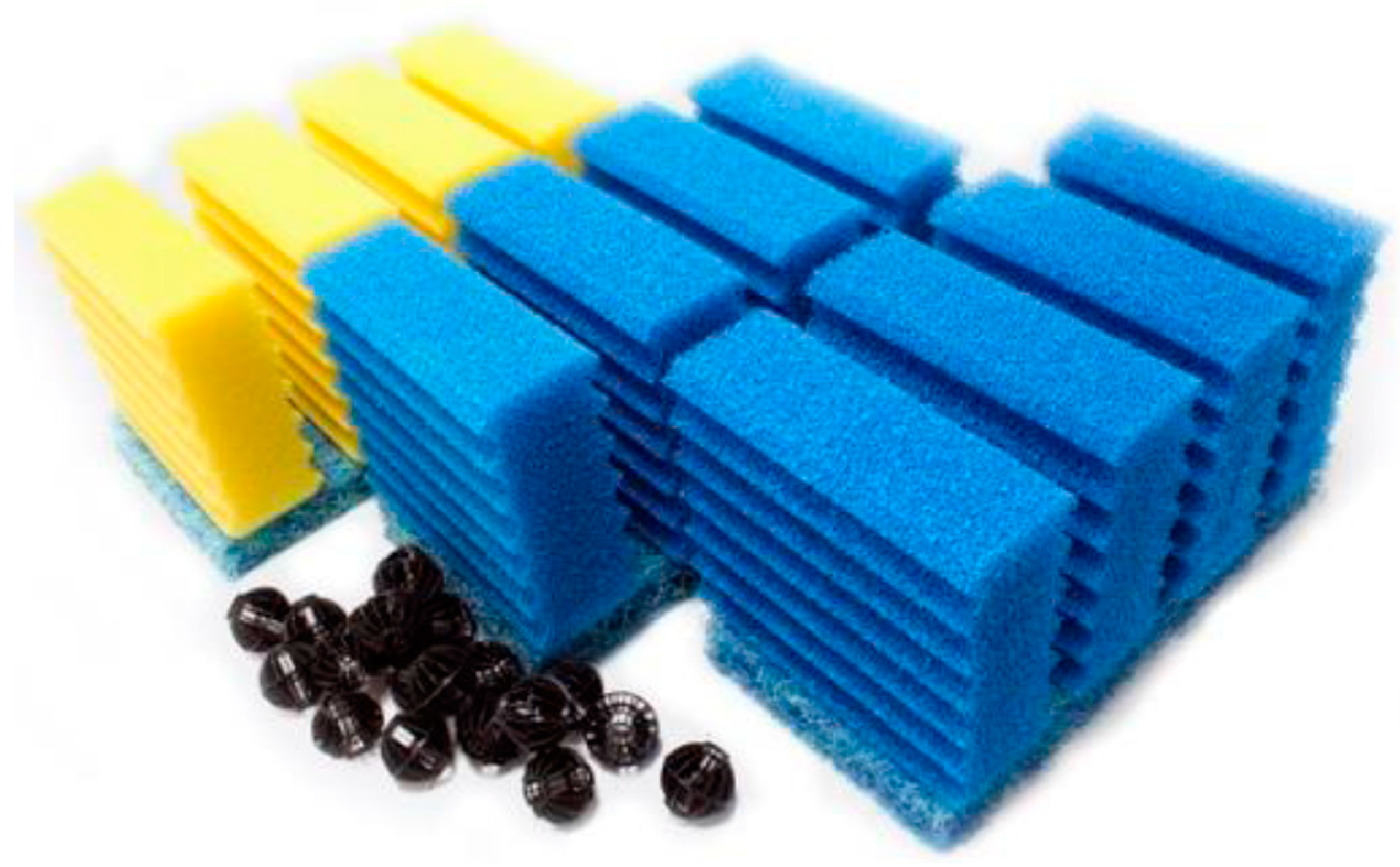


Disclaimer/Publisher’s Note: The statements, opinions and data contained in all publications are solely those of the individual author(s) and contributor(s) and not of MDPI and/or the editor(s). MDPI and/or the editor(s) disclaim responsibility for any injury to people or property resulting from any ideas, methods, instructions or products referred to in the content. |
© 2023 by the authors. Licensee MDPI, Basel, Switzerland. This article is an open access article distributed under the terms and conditions of the Creative Commons Attribution (CC BY) license (https://creativecommons.org/licenses/by/4.0/).
Share and Cite
Walczak, W.; Serafin, A.; Siwiec, T. Natural Swimming Ponds as an Application of Treatment Wetlands—A Review. Water 2023, 15, 1878. https://doi.org/10.3390/w15101878
Walczak W, Serafin A, Siwiec T. Natural Swimming Ponds as an Application of Treatment Wetlands—A Review. Water. 2023; 15(10):1878. https://doi.org/10.3390/w15101878
Chicago/Turabian StyleWalczak, Wojciech, Artur Serafin, and Tadeusz Siwiec. 2023. "Natural Swimming Ponds as an Application of Treatment Wetlands—A Review" Water 15, no. 10: 1878. https://doi.org/10.3390/w15101878




